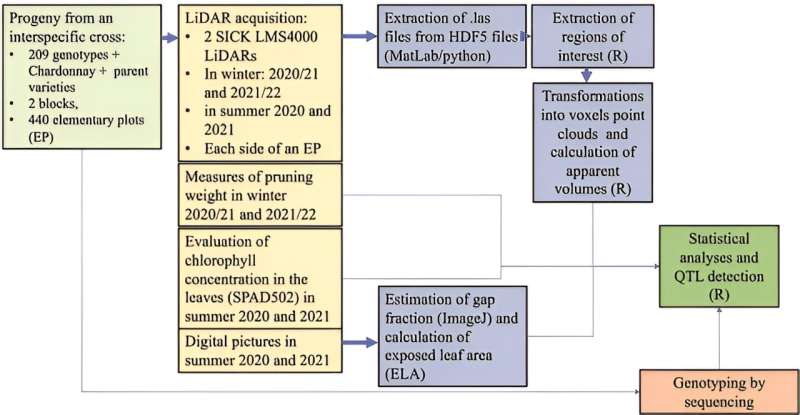This article has been reviewed according to Science X's editorial process and policies. Editors have highlighted the following attributes while ensuring the content's credibility:
fact-checked
proofread
Grapevine phenotyping: Harnessing LiDAR for enhanced growth assessment and genetic insights

In response to the pressing need to reduce pesticide usage and adapt grapevine varieties to climate change, there's an unprecedented effort to phenotype new genotypes using high-throughput methods.
Teams globally are developing advanced systems, employing technologies like multispectral cameras and LiDAR, to assess growth traits, photosynthetic capability, and other architectural parameters. However, traditional methods remain time-consuming and less efficient for large-scale studies.
The current research gap lies in effectively employing LiDAR technology to explore genetic factors affecting grapevine vigor for sustainable viticulture.
In November 2023, Plant Phenomics published a research article titled "LiDAR Is Effective in Characterizing Vine Growth and Detecting Associated Genetic Loci."
The study assessed growth traits in 209 grapevine genotypes using methods such as fresh pruning wood weight, exposed leaf area from digital images, leaf chlorophyll concentration, and LiDAR-derived volumes. It found six genomic regions associated with trait variations, validating LiDAR as an effective tool for characterizing grapevine growth.
LiDAR-derived canopy volumes showed strong correlations with traditional methods, and pruning wood volume from LiDAR positively correlated with actual pruning weight. However, some relationships varied between seasons, indicating that LiDAR provided more consistent measurements overall.
Traits except exposed leaf area (ELA) in certain years met normality criteria, and parents displayed significant differences for most traits. LiDAR-derived traits exhibited high, stable heritability, outperforming traditional methods. These traits also led to effective genetic models explaining substantial phenotypic variance.
The study generated high-density genetic maps and identified quantitative trait loci (QTLs) associated with growth traits. It found stable QTLs across seasons and validated the genetic determinism of grapevine vigor using LiDAR. The study also noted that LiDAR-derived volumes at veraison (onset of ripening) and winter were more reliable and heritable than traditional methods, and powerful QTL detection confirmed their efficacy.
In summary, this research underscores the potential of LiDAR technology for high-throughput phenotyping and genetic studies of grapevine growth, providing a more efficient alternative to conventional methods. It opens avenues for understanding environmental effects, management techniques, and training systems on grapevine growth, moving towards more detailed genetic insights into grapevine vigor and architecture.
More information: Elsa Chedid et al, LiDAR Is Effective in Characterizing Vine Growth and Detecting Associated Genetic Loci, Plant Phenomics (2023). DOI: 10.34133/plantphenomics.0116
Provided by Plant Phenomics




















